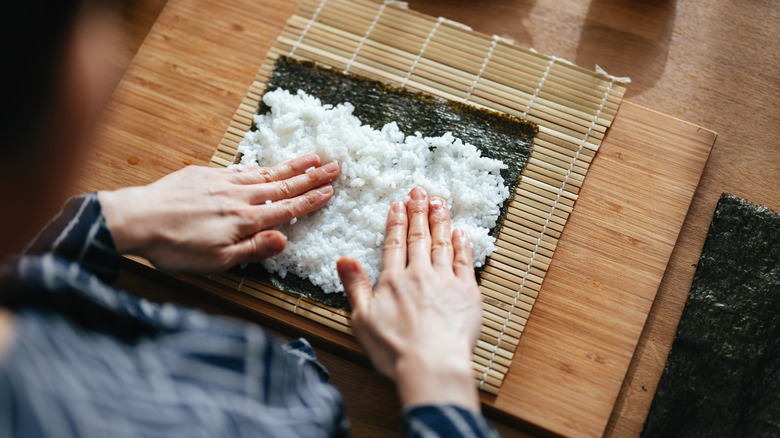Don't Make This Common Rice Mistake When Rolling Sushi At Home
Making sushi at home doesn't have to be as difficult as you may imagine, and with the right tools and ingredients, doing so can produce an easy and fun homemade meal. Yet one of the key components that makes sushi what it is, of course, is that seasoned rice. In an exclusive interview with Food Republic, George Ruan, Chef at New York sushi restaurant Jōji, told us all about the mistake you just might be making when rolling your sushi at home.
"Sushi rice is spiced with a special vinegar," Ruan noted, referring to — you guessed it — rice vinegar. Not to be confused with rice wine, rice vinegar is used in sushi to find the right balance of salty and sour taste; it also helps the rice stay sticky and prevents it from drying out.
So as much as rice is the key to making sushi, rice vinegar literally keeps it all together. You can absolutely make your own sushi rice at home, but Ruan strictly says to never make your own rice vinegar and always buy it in-store. Ruan also tells sushi makers to "make sure to buy Japanese rice because it's higher quality rice, which means better sushi." Japanese rice is rounder and shorter; plus. it has more starch, making it ideal for shaping into sushi. You can buy it in most grocery stores along with rice vinegar, so you have the perfect base for your homemade sushi.
Assembling your sushi rice and rolls
Once you have your Japanese rice and rice vinegar, you only need to combine them with a few teaspoons of salt and sugar to make sushi rice. The flavor will be well-rounded, and your rice should stick together nicely thanks to the vinegar. Your sushi rice will then be ready to spread onto your seaweed as a filling for your sushi rolls. The seaweed, aka nori, is held together by the stickiness of the rice and, if handled delicately, will also help hold it together. Of course, the nori does occasionally break, but Chef George Ruan says not to worry: You can save the rice and "use a new sheet of seaweed and just roll again."
Sushi connoisseurs will also know that a key to wrapping the seaweed and rice is using a bamboo mat to roll the sushi tightly and not stick to surrounding surfaces. While they are a fairly inexpensive tool, first-time sushi makers may not want to go all on buying so many products — fortunately, there's an easy way to make sushi without a bamboo mat. All you'll need is a dish towel and plastic wrap, which is great for a lower-stakes sushi night. But, bamboo mat or not, you'll still need to buy and properly prepare the right rice, so your sushi can be successful from the get go.


